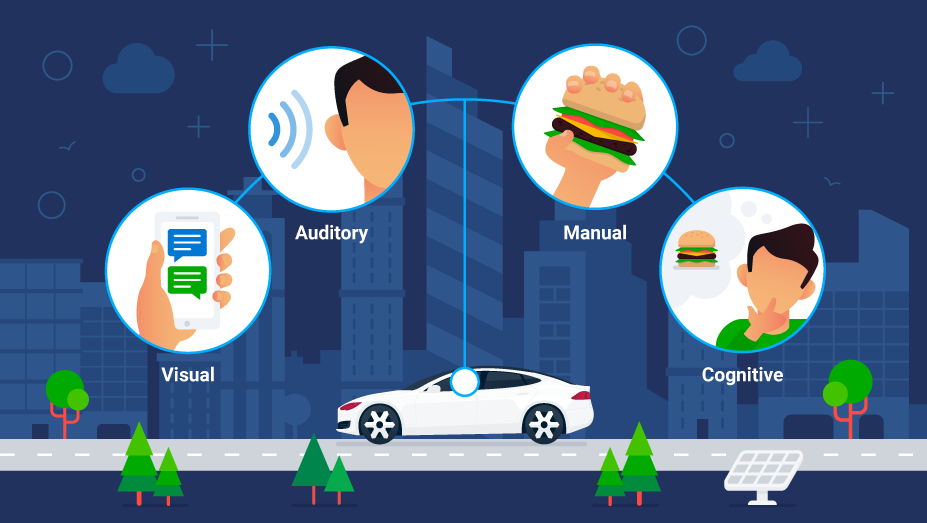Distracted driving policy: Frequently asked questions (FAQs)
Statistics and facts to support your distracted driving policy and how telematics can help with fleet safety.


There is a reason why we see so many distracted driving road signs on the highway, such as “Hands on the wheel. Eyes on the road.” According to the Centers for Disease Control and Prevention, about eight people are killed every day in crashes that are reported to involve distracted drivers in the United States. The same report suggests that texting is the biggest cause of distracted driving.
According to the National Highway Traffic Safety Administration, sending or reading a text takes your attention away from the wheel for five seconds. At 55 mph, that's like driving the length of an entire football field with your eyes closed. The National Safety Council (NSC) estimates that 42,000 people were killed in motor vehicle crashes in 2020. A preliminary report released by NSC suggests that there’s a 16% increase in motor vehicle deaths in just the first six months of 2021.
What is distracted driving?
Distracted driving can be many things: eating or drinking, road rage, looking at other drivers, kids in the car, tuning the stereo or navigation system, talking to other passengers, applying makeup and most common of them all, using your cell phone.
Any time drivers divert their attention away from the road and focus on something else, it is defined as a distraction, according to Global Fleet Champions. Interruptions can occur both inside as well as outside the car.
The non-profit global campaign to prevent crashes and reduce pollution, Global Fleet Champions is a partnership initiative administered by Brake, the road safety charity.
What are the different types of distracted driving?
There are four types of driver distractions:

- Visual: When a driver looks at something other than the road. It could be their phone, billboards, or pedestrians on the sidewalk.
- Auditory: When the driver is distracted by loud music, hands-free calls, or other sounds that cause their attention to shift from the wheel.
- Manual: The driver is simply doing something else other than driving. It could be grooming, eating, or fiddling with the stereo system.
- Cognitive: When the driver's attention is elsewhere and not exactly on driving or on the road.
Distracted driving statistics and facts
A distracted driver is less likely to respond to a collision or hazard and is more likely to be involved in a crash, according to the Global Fleet Champions. Just a second away from the wheel can be fatal or cause the passengers serious injuries. Here are a few statistics listing the consequences of distracted driving.
- 98% of drivers cannot share attention across tasks without losing driving performance.
- 65% of near-misses are caused by drivers not paying attention.
- 93% of rear-end crashes involve visual distraction.
- 1,000 people get injured every day in crashes related to distracted driving.
- Drivers who talk on phones are four times more likely to be in a crash resulting in injuries.
- 35% of crashes may involve drinking and driving.
See more fast facts by Global Fleet Champions.
How can fatigue affect the driver’s ability to focus on the road?
A common example of a cognitive driving distraction is driver fatigue. Fatigue impairs a person's ability to be alert and affects their driving ability no matter their level of experience. A driver feeling fatigue is at a higher risk of being involved in a collision. Check out the Trucking Fatigue Meter, a Geotab Marketplace solution that monitors driver fatigue across an entire fleet and proactively engages with drivers to discuss the risk that fatigued driving poses to safety.

How do you prevent fatigue while driving?
The report shared by Global Fleet Champions gives professional-driver employers guidance on best practices for managing occupational road risk, regardless of budget, fleet size, or vehicle type.
This report dives deeper into the causes and consequences of fatigue. It also recommends measures a fleet manager could take to identify and reduce the risks of driver fatigue within their fleet. Managing fatigue is a shared responsibility between a company and the driver. Here are a few points that each of them can take to improve driver safety.
Company:
- Make sure driving shifts include enough breaks for recovery between shifts. Drivers need to have a work/life balance. They should have enough time to rest, eat, spend time with family, and do their regular chores.
- Provide employees with information and tools to enable them to manage their personal fatigue risk.
- Treat all reports of fatigue seriously.
Individual:
- Take time to have enough breaks. Drivers should use their rest time.
- Manage out-of-hours activities so they do not adversely affect work performance.
- Report operational or personal factors that could increase fatigue risk.
What is a distracted driving policy?
According to a report in IIHS-HLDI, 4,119 people died in truck crashes in 2019. After analysis, it was reported that 16% of these deaths were truck occupants, 67% were passengers in cars and 15% were pedestrians, cyclists, or motorcyclists.
The cost of distracted driving for companies is high, considering potential costs related to injuries and liability. Therefore, employers are responsible for maintaining the safety of their workers, and setting up an effective distracted driving policy is part of this. This directive helps provide guidelines to employees and anyone who might be involved in a collision.
How do you build an effective distracted driving policy?
A functional distracted driving policy is practical, states different dos and don'ts and highlights the importance of driver safety.
Here are a few quick steps a company can take to make sure its distracted driving policy is most effective:
1. Cover the subject well
Make sure the policymakers include all the information and cover areas of concern. Research and compare your company's distracted driving policy with that of other companies and implement pointers that you might have missed. Also, check expert sites such as the National Safety Council for accurate facts.
2. Create a policy for all
This distracted driving policy should apply to everyone in the company: fleet drivers, car drivers, delivery drivers, or anyone who drives a vehicle. Make sure the policy is well communicated with every single member of the company.
3. Educate your employees
All the employees in the company need to receive proper training and education regarding the distracted driving policy. Organizing seminars, discussions and interactive sessions are a good way to drive the point home. The goal of these exercises is to make sure every employee understands the importance and impact of the policy and implements them accordingly. Employers need to understand the importance of training their employees and continue to coach them with updated information for the safety of all.
4. Promote and refresh your policies and procedures
Every once in a while, remind all the employees to go through the policy, refresh their memory about why it is important to follow the policy and why it must be reinforced. Also, inform your team about any updates made to the policy.
Image caption: Distracted driving pointers provided by Global Fleet Champions.
How can you enforce a distracted driving policy?
Creating a policy document is not enough. It has to be followed up with education, monitoring, and enforcement.
Here are a few pointers that will help you enforce a distracted driving policy in your company:
- Clearly communicate to all employees the consequences of violations.
- Identify performance indicators that are easy to measure and manage.
- Implement driver scorecards that will make the drivers accountable for their actions. Driver scorecards also help identify members who need additional training.
- Motivate the drivers by “gamifying” the safety program.
- A seat belt report is a great way to know driver violations and will help fleet managers take necessary action.
- Use an effective fleet safety management solution.
How can telematics help improve fleet safety?
Fleet safety is a key pillar of the Geotab fleet management solution. Telematics can support a company’s safety program and distracted driving policy with in-vehicle driver coaching, instant collision notification and risk and safety reporting. Global Fleet Champions reported that 90-95% of collisions involve preventable driver errors.
Using data to combat distracted driving
Vehicle tracking devices help procure data that can then be used to pinpoint dangerous driving. There are three main types of data that fleet managers should look out for: vehicle acceleration, vehicle road speed and vehicle engine speed.
These data points can help improve driving behaviors by generating safety dashboard reports, custom safety alerts, advanced collision systems, trip history and rules setting.
You can also monitor fleet safety in real-time and track speeding, harsh braking, and harsh cornering. All this information can help you effectively coach the drivers and prevent distracted driving. Trend reports can identify which fleet drivers need additional training.

Help drivers avoid distracted driving with camera technology
With telematics and connected solutions like dash cameras, you can monitor both vehicles and drivers in real-time, helping maintain the overall safety of the fleet. By taking proactive measures to reduce vehicle collisions and tackling fleet safety head-on, you’re investing in the well-being of your drivers and helping lower fleet costs associated with crashes and injuries.
Distracted driving cameras provide high-definition footage and video clips that can be used later as valuable training resources for your drivers. Cameras are powered with machine vision and artificial intelligence.

Provide timely feedback to improve drive performance
Want to give your drivers feedback? Make use of the buzzer alert or GO TALK which provides spoken instructions in the vehicle. These real-time tips can most certainly help your fleet driver improve their driving skills.
Pay heed to the forward collision warning
How helpful would it be if you could be warned of a possible collision seconds before it happened? The Mobileye Collision Avoidance System does just that. The system continuously monitors the road and prompts the driver of possible collisions, unintended lane departures, tailgating and pedestrian and cyclist hazards.
Road safety is a shared responsibility
Drivers, fleet managers, cyclists, pedestrians, employers, policymakers, governments, road designers and manufacturers can all contribute towards the safety of one another. When all stakeholders work hand-in-hand, we can help make the roads safer for everyone.
Geotab also supports educational and awareness campaigns to shed light on dangerous driving. One such event is the Phones Down Eyes Up benefit concert that is organized every year with the purpose of bringing awareness around distracted driving.
Geotab's commitment to safety extends from developing fleet management solutions that can help improve safety on both sides of the wheel to spearheading community initiatives. To learn more about tracking your own safety score, visit our fleet safety management page and request a demo.
Originally published on April 18, 2016.
Subscribe to get industry tips and insights

Mrinalini Sundar is a content coordinator at Geotab
Table of Contents
- What is distracted driving?
- What are the different types of distracted driving?
- Distracted driving statistics and facts
- How can fatigue affect the driver’s ability to focus on the road?
- How do you prevent fatigue while driving?
- What is a distracted driving policy?
- How do you build an effective distracted driving policy?
- How can you enforce a distracted driving policy?
- How can telematics help improve fleet safety?
- Help drivers avoid distracted driving with camera technology
- Provide timely feedback to improve drive performance
Subscribe to get industry tips and insights
Related posts

Unlocking Safer Roads: How Behavioral Science and Technology Are Improving Driver Safety
April 14, 2025
2 minute read

What is government fleet management software and how is it used?
April 10, 2025
3 minute read

Beyond the road: Enhancing school bus interior safety with advanced technology
April 10, 2025
5 minute read

How a well-built fleet safety culture prevents legal trouble
March 28, 2025
5 minute read

Driver behavior monitoring systems: Fleet managers’ guide for top tools + implementation tips
March 27, 2025
7 minute read
